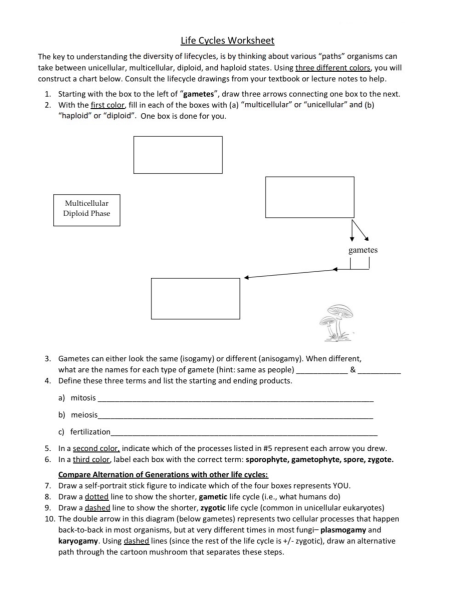Questions
Life cycles worksheet the key to understanding the diversity
 Life Cycles Worksheet
Life Cycles Worksheet
The key to understanding the diversity of lifecycles is by thinking about various "paths" organisms can take between unicellular, multicellular, diploid, and haploid states. Using three different colors, you will construct a chart below. Consult the lifecycle drawings from your textbook or lecture notes to help.
- Starting with the box to the left of "gametes", draw three arrows connecting one box to the next.
With the first color, fill in each of the boxes with (a) "multicellular" or "unicellular" and (b) "haploid" or "diploid." One box is done for you.
- Gametes can either look the same (isogamy) or different (anisogamy). When different, what are the names for each type of gamete (hint: same as people)?
_________________ & ___________________
- Define these three terms and list the starting and ending products.
a) mitosis
___________________________________________
b) meiosis
___________________________________________
c) fertilization
___________________________________________
- In a second color, indicate which of the processes listed in #5 represent each arrow you drew.
- In a third color, label each box with the correct term: sporophyte, gametophyte, sporocyte, zygote.
- Compare Alternation of Generations with other life cycles:
- Draw a self-portrait to sketch to indicate which of the four boxes represents YOU.
- Draw a diagram to show the shorter, zygotic life cycle (i.e., common in unicellular eukaryotes).
- The double arrow in the diagram (below) represents the processes that happen back-to-back in some organisms, but a very different process in most fungi—plasmogamy and karyogamy.
Using dashed lines (since the rest of the life cycle is /zygote), draw an alternative path through the cartoon mushroom that separates these steps.
Answers :
1. Starting with the box to the left of "gametes", draw three arrows connecting one box to the next.
With the first color, fill in each of the boxes with (a) "multicellular" or "unicellular" and (b) "haploid" or "diploid." One box is done for you.
- The first box: Diploid (Multicellular)
- The second box: Haploid (Unicellular)
- The third box: Diploid (Multicellular)
2. Gametes can either look the same (isogamy) or different (anisogamy).
When different, what are the names for each type of gamete? (hint: same as people)
Male Gamete: Sperm
Female Gamete: Egg
3. Define these three terms and list the starting and ending products.
a) Mitosis
Definition: Mitosis is a type of cell division that results in two genetically identical daughter cells.
Starting Product: One diploid parent cell
Ending Product: Two diploid daughter cells
b) Meiosis
Definition: Meiosis is a type of cell division that reduces the chromosome number by half, resulting in four non-identical gametes.
Starting Product: One diploid parent cell
Ending Product: Four haploid gametes
c) Fertilization
Definition: Fertilization is the process where two haploid gametes (sperm and egg) unite to form a diploid zygote.
Starting Product: Two haploid gametes
Ending Product: One diploid zygote
4. In a second color, indicate which of the processes listed in #5 represent each arrow you drew.
- Process 1: Mitosis
- Process 2: Meiosis
- Process 3: Fertilization
5. In a third color, label each box with the correct term: sporophyte, gametophyte, sporocyte, zygote.
- Box 1: Sporophyte
- Box 2: Gametophyte
- Box 3: Sporocyte
- Box 4: Zygote
6. Compare Alternation of Generations with other life cycles:
Alternation of generations involves two generations: a diploid (sporophyte) and a haploid (gametophyte) stage. This process is common in plants, algae, and fungi. Unlike other life cycles, such as the zygotic life cycle (where the zygote directly undergoes meiosis), alternation of generations results in two distinct multicellular stages.
7. Draw a self-portrait to sketch to indicate which of the four boxes represents YOU.
The box representing you would be the diploid stage (you are a multicellular diploid organism).
8. Draw a diagram to show the shorter, zygotic life cycle (i.e., common in unicellular eukaryotes):
- Start with the haploid gametes (from both male and female).
- The gametes fuse (fertilization) to form a diploid zygote.
- The zygote undergoes meiosis to form new haploid gametes, which can go on to fuse again.
This cycle includes no multicellular diploid stage.
9. The double arrow in the diagram (below) represents the processes that happen back-to-back in some organisms, but a very different process in most fungi—plasmogamy and karyogamy. Using dashed lines (since the rest of the life cycle is /zygote), draw an alternative path through the cartoon mushroom that separates these steps.
- Plasmogamy: The fusion of cytoplasm from two parent cells.
- Karyogamy: The fusion of the nuclei after plasmogamy.
Summary
This diagram represents different life cycles in organisms, with specific attention to mitosis, meiosis, fertilization, and processes like plasmogamy and karyogamy that vary across species. Understanding these processes and how they fit together helps in studying organism development, reproduction, and the alternation of generations.
Answered By

